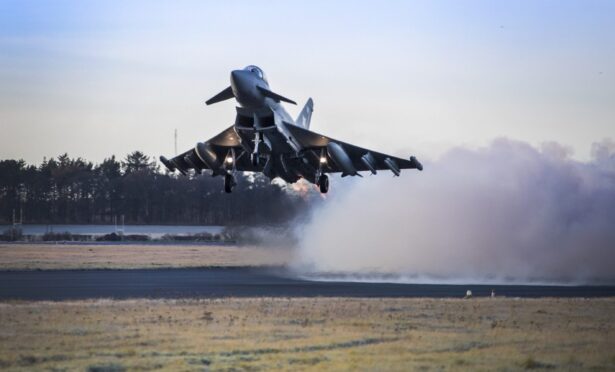RAF fighter jets from Lossiemouth were scrambled to monitor Russian military aircraft near UK airspace.
The Ministry of Defence (MOD) said typhoons were deployed from RAF Lossiemouth to monitor a Russian Bear-F aircraft flying over the North Sea.
The incident was the second time in three months the Royal Navy and RAF have detected Russian ships and aircraft in UK airspace.
In a statement from the MOD, officials said: “The Russian reconnaissance plane had been detected in the UK’s area of interest and at no time was it able to enter UK sovereign airspace.
“The Typhoons, which were supported by a Voyager refuelling aircraft, are part of the RAF’s Quick Reaction Alert.
“This sees aircraft in Scotland and England at high readiness 24/7, 365 days a year, ready to defend and protect UK airspace.”
Over the last week, the Royal Navy shadowed Russian military vessels passing through the English Channel.
Luke Pollard, armed forces minister, said: “Our adversaries should be in no doubt of our steadfast determination and formidable ability to protect the UK.
“The Royal Navy and RAF have once again shown they stand ready to defend our country at a moment’s notice and I pay tribute to the professionalism and bravery of those involved in these latest operations.”
HMS Iron Duke and RFA Tideforce shadowed three Russian vessels
The scrambling follows British warships, helicopters, and long-range maritime patrol aircraft keeping close watch on the progress of two separate groups of Russian ships as they sailed in opposite directions – one bound for the Atlantic and the other towards the Baltic.
This ensured the ships acted in a safe and non-threatening manner.
In the Channel, HMS Iron Duke and tanker RFA Tideforce shadowed three Russian vessels, which were led by the new frigate Admiral Golovko.
The Golovko was accompanied by oceanographic research vessel Yantar and supporting tanker Vyazma. All three had been tracked by the Norwegian Navy before British forces took over. The Duke class frigate and Tide-class tanker, supported by an RAF P-8 Poseidon maritime patrol aircraft, followed the ships through the Dover Strait and Channel before handing over monitoring duties to the French Navy.
As the Golovko continued her journey, Iron Duke took over shadowing duties of the second Russian group.
Frigate Neustrashimy and her support ship, tanker Akademik Pashin were travelling to their home port in the Baltic.
Iron Duke remained in contact with the pair back through the Channel and into the North Sea before handing over to a Dutch warship.
Our reporters are working to bring you the latest updates on this developing story. Please check back later for more and follow The Press and Journal on Facebook and online for breaking news.

Conversation